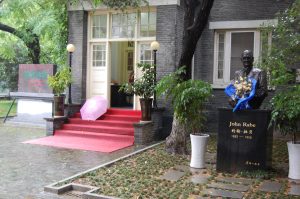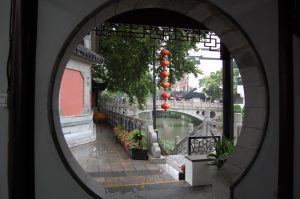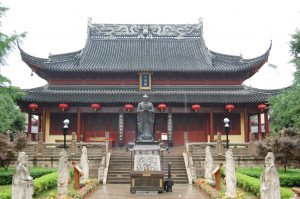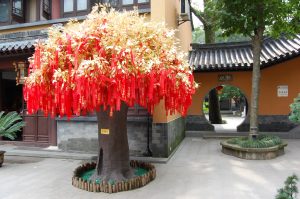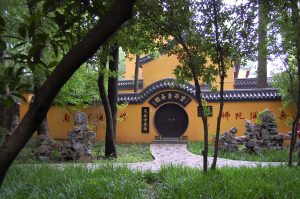The fast train from Shanghai to Nanjing, around 300 km, takes two hours. Faster ones leave in the morning, taking 1,5 hour, but too early for me. The fare costs 140 Yuan. Changing to the Metro for 2 Yuan and few more stations I am at my destination: Zhujianglu station right in the middle of Nanjing, the Southern Capital.
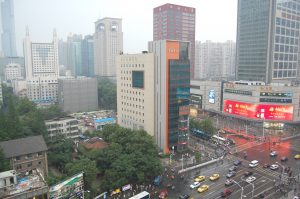
The house with red roof and surrounded by trees: former residence of John Rabe, today a Research and Exchange Centre for Peace and Reconciliation. The area behind it: The University of Nanjing
On the other side of the road opposite to the metro station there is my accomodation on the 14th floor for the next few days. Next to the metro station on the corner of Xiaofen qiao and Guangzhou road I find by chance the former residence of John Rabe, also called by the Chinese “the good German of Nanjing”.
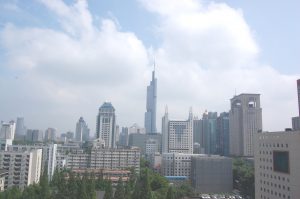
A bit further: the Zifeng Tower, with 450 m the highest building in Nanjing
A short synopsis about John Rabe:
As representative of the Siemens company in Nanjing, and member of Hitler’s party NSDAP in the meanwhile, Rabe tried to save the Nanjinger people from massacring by the Japanese army at the end of 1937 when Nanjing fell to their invasion. Together with initially 15 other Westerners, seven had to leave later on, the nine remnants with Rabe as the leader, set up a committee to negotiate with the Japanese invaders to create a safety zone of 2×2 km surrounding the western diplomatic consulates and the university of Nanjing. More than 200.000 civilians of Nanjing were given asylum in this area, provided with food and shelter, saving them from looting, raping and murdering by the Japanese invaders. At least for a short while.
Rabe himself took more than 650 Nanjingers into his house and garden. Hitler’s Germany was allied with Japan by the Anti-Comintern Pact at that time. Rabe spanned a 3×6 m large white swastika flag in his garden hoping to be spared of air raids by the Japanese. In fact, many Najinger found a shelter for life under this flag.
In February 1938 Rabe was withdrawn by Siemens back to Germany. In Berlin he gave several lectures about the Japanese atrocities to the public and submitted a personal report to Hitler. But he was then stopped by the Gestapo and banned from publishing the Japanese massacre in Nanjing. By the end of the war, John Rabe could initially not be denazified due to his NSDAP membership which made him living in poverty. In 1948, the people of Nanjing learned of his dire straits and quickly raised a large sum of money to provide him and his family with food and a monthly care package in the following months. Rabe died of a stroke in 1950.
Nanjing was the capital of six dynasties and the Republic of China (1912-1949). With the urban population of 6,5 million and many universities it is a thriving metropolis nowadays.
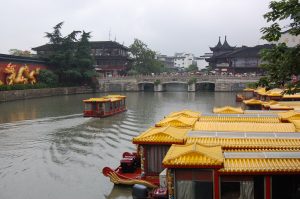
Qinhuai River, a branch of Yangtze
The Confuzius temple was originally constructed in 1034. Damaged and rebuilt several times. Burnt down in 1937 by Japanese invaders. It was rebuilt in 1984.
Situated on the bank of Qinhuai river (metro station Sanshanjie) Fuzimao is surrounded by bustling shopping malls and pedestrian zones with lots of shops, restaurants, cafés and “tourist supermarkets”. Nearby there are the ancient Jiangnan Gongyuan (Imperial Examination Hall) and Xue Gong (Imperial Academy). In the olden days there was also a brothel in this flourishing district on the riverside where extravagant nobles, businessmen, talents and scholars flocked to the restaurants, dance halls and other enjoyment of life.
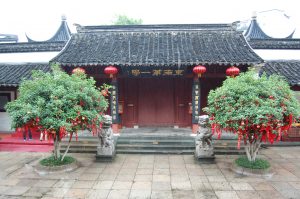
First school in the southeastern China
Over 1300 years and until its abolition in 1905 the imperial examination was the entrance gate into the civil service posting and an official career ladder of the imperial China. It based on knowledge of the classics and literary style, not on technical expertise.
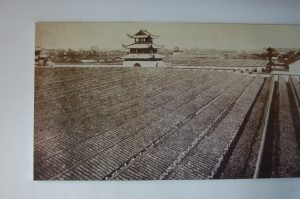
Photograph of the Imperial Examination Hall, constructed in 1168 AD (Imperial Examination Museum, Nanjing). The hall was over 30 ha in size, consisting of 20.644 examination cells. Examinee spent nine days and six nights in the cell for the exam which was held once every three years
Also, the exam helped to shape China’s intellectual, cultural, political life and to promote cultural unity. On the other side this system stifled creativity and aggravated China’s lack of technical knowledge and its defeat by foreign powers.
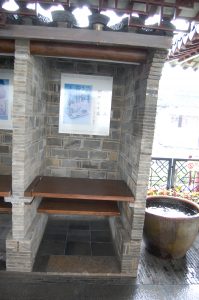
A examination cell (reproduction, Imperial Examination Museum, Nanjing)
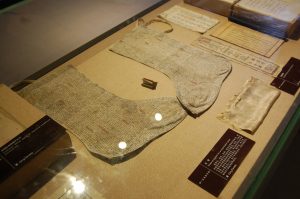
Where there is an exam there is a cheat: mini booklet as crib sheet (between the socks). Fine inscription on the socks as aide-mémoire. (Imperial Examination Museum, Nanjing)
In the northeast suburb of Nanjing there is the Zhongshan (Chinese first name of Dr Sun Yat-Sen) Park, metro station Muxuyuan. Beside Dr Sun Yat-Sen´s mausoleum the park has other sightseeing attractions like Linggu temple, Linggu pagoda, Emperor Mingxiaoling´s tomb, built 1431, Wu Liang Hall, Song Meiling villa and so on.
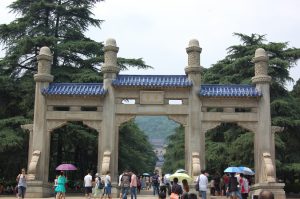
Entrance to Dr Sun Yat-Sen´s Mausoleum
Dr Sun Yat-Sen, born on 12 November 1866, as son of a Hakka family, a Han Chinese ethnic group from the Guangdong province in China. He moved at the age of 10 to live with his elder brother to start schooling in Honolulu, Haiwai. At the age of 17 he was sent home back to China in 1883, but shortly thereafter he had to flee to Hong Kong as he and a friend broke the god statue in the village temple because they were dissatisfied with the ancient healing method by worshipping the god.
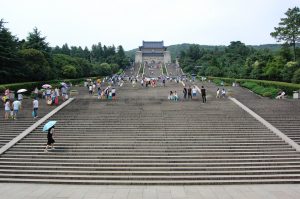
The stairs leading to Mausoleum
This provoked the wrath of the villagers. In Hong Kong he continued his education and studied medicine in 1886. He qualified as a medical doctor at the Hong Kong College of Medicine for Chinese in 1892. Later on, he concentrated his work in the politics and played a major role in overthrowing the last Emperor Puyi of the Qing dynasty in 1911 and so ending the 2.000 year imperial period of China.
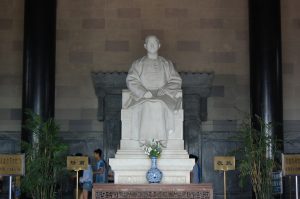
Dr Sun Yat-Sen´s statue on top of the hill
Dr Sun Yat-Sen is considered as one of the greatest leaders of modern China, as Father of the Nation in the Republic of China. He served as its first provisional President, and as an uniting figure in post-imperial China he is widely accepted by both the Communist Party and the Kuomintang (the Chinese Nationalist Party). The latter lost in the 10 year civil war with the communist and was forced to exile in Taiwan in 1949 until today.

Buddhist Linggu temple, originally built in 515 AD

Linggu Pagoda, built in 1929, commemorating the fallen soldiers in the Northern Expedition by Chiang Kai-shek 1926-28
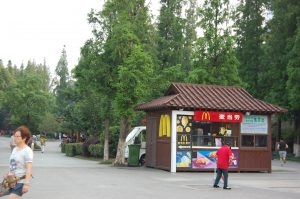
Where there is a gathering there is a eatery. Don´t be afraid of starving or being alone somewhere. In most cases Mac or KFC will be there
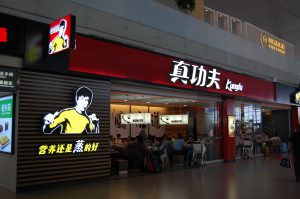
Don´t even think, burger is the new gourmet food of China. This is the Chinese response in fast food.


